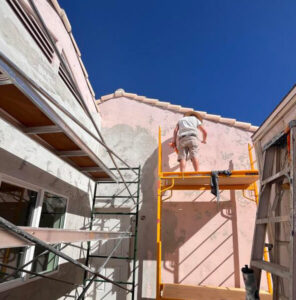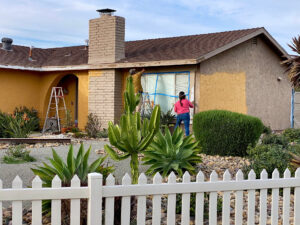A fresh coat of paint can completely transform a space, whether you’re repainting a room in your home or updating your commercial property. The excitement of choosing a new color and seeing the final result often causes people to rush into the job. The secret to a flawless, long-lasting finish isn’t in the brushstroke; it’s in the preparation. Skipping crucial prep steps is one of the most common mistakes in both residential painting and commercial painting projects.
To help you achieve a professional-quality result, we’ve created a helpful prep list. This guide covers the top seven things most people forget before they even open a can of paint. By paying attention to these details, you can avoid common frustrations and ensure your project is a success from start to finish.
Your Ultimate Painting Prep List
1. Thoroughly Cleaning the Surfaces
Paint needs a clean, dry surface to adhere properly. Over time, walls collect dust, grime, grease, and fingerprints. Painting directly over these contaminants can lead to peeling, blistering, or an uneven finish. This is especially critical in kitchens where grease can build up or in commercial spaces with high traffic.
Before you begin, wash all surfaces with a mild detergent and water solution. For tougher stains or greasy areas, a dedicated degreasing cleaner might be necessary. Use a sponge or cloth to scrub the walls, then rinse them with a clean, damp cloth. Allow the walls to dry completely before moving on to the next step. This simple but often overlooked task is fundamental to the longevity of your new paint job.
2. Performing Detailed Surface Repairs
A new coat of paint will not hide cracks, holes, or dents. In fact, it can often make them more obvious. Take the time to inspect every wall and ceiling surface for imperfections. Look for nail holes, settlement cracks, chips, and any uneven textures.
Use a quality spackling compound or wood filler to patch these blemishes. Apply the filler with a putty knife, slightly overfilling the hole or crack to account for shrinkage as it dries. Once it’s fully cured, sand the repaired area smooth until it is flush with the surrounding wall. Wiping the sanded area with a damp cloth will remove any dust, creating a perfect canvas for your primer and paint.
3. Protecting Your Floors and Furniture
Paint has a way of getting everywhere you don’t want it to. A few stray drips or splatters on your flooring or furniture can create a cleanup nightmare. Many people underestimate how much coverage they truly need. A single, thin plastic sheet often isn’t enough, as it can tear easily or shift during the project.
For full protection, move as much furniture out of the room as possible. For larger items that must stay, move them to the center of the room and cover them completely with durable plastic sheeting. Secure the sheeting with tape. For floors, use heavy-duty canvas drop cloths. They are more absorbent, less slippery, and more tear-resistant than plastic, providing superior protection for your carpets, tile, or hardwood.
4. Removing or Taping Fixtures and Hardware
Painting around light switch plates, outlet covers, doorknobs, and window hardware is a recipe for messy edges and a less-than-professional look. While it might seem faster to just tape around them, the best approach is to remove them entirely.
Unscrew and take off all plates and hardware. Store them in labeled plastic bags with their corresponding screws so you can easily put them back in the right place later. For fixtures, you can’t remove, like large light fixtures or window frames, use high-quality painter’s tape to create a sharp, protective border. Taking these extra minutes will save you from tedious touch-ups and result in clean, crisp lines.
5. Investing in Quality Primer
Many DIY painters are tempted to skip primer to save time and money, especially if they’re painting over a similar color. This is a significant mistake. Primer serves several essential functions: it blocks stains, creates a uniform surface for the paint to adhere to, and ensures the true color of your paint comes through.Using a primer is non-negotiable when painting over new drywall, dark colors, or glossy surfaces. It is also a key step in projects like DIY painting kitchen cabinets, where adhesion is critical for durability. A good primer seals the surface, preventing the new paint from soaking in unevenly. This not only improves the final look but can also reduce the number of topcoats you need, ultimately saving you paint.
6. Choosing the Right Paint Sheen
The color is important, but the paint’s sheen, or finish, is just as crucial. The sheen affects the paint’s durability, appearance, and how easy it is to clean. People often forget to consider how the room will be used when selecting a finish.
Here’s a quick guide:
- Matte/Flat: Has no shine and is great for hiding imperfections. Best for low-traffic areas like adult bedrooms and ceilings.
- Eggshell/Satin: Offers a soft, low-sheen finish that is more durable and easier to clean than flat paint. It’s a popular choice for repainting a room like a living room or hallway.
- Semi-Gloss: This durable, reflective finish is perfect for high-moisture areas like bathrooms and kitchens. It’s also great for trim, doors, and projects like DIY painting kitchen cabinets because it stands up well to scrubbing.
- High-Gloss: The most durable and reflective option, high-gloss paint is ideal for surfaces that take a lot of wear, such as doors, trim, and cabinetry.
7. Calculating How Much Paint You Really Need
There’s nothing more frustrating than running out of paint midway through a project. On the other hand, buying too much is a waste of money. Most people either guess or buy just one gallon, hoping it will be enough. Taking a few minutes to calculate your needs will prevent an extra trip to the store.
To estimate, measure the total perimeter of the room. Then, measure the height of the walls from the floor to the ceiling. Multiply the perimeter by the height to get the total square footage. A general rule is that one gallon of paint covers about 350-400 square feet with one coat. Don’t forget to subtract for large windows and doors, but it’s always wise to buy a little extra for touch-ups.
Get Professional Results Without the Hassle
Proper preparation is the most important part of any painting project, whether it’s a simple residential painting job or a large-scale commercial painting endeavor. While this prep list can guide you through a DIY project, achieving a truly flawless finish requires expertise, precision, and time.
If you want to ensure your painting project is completed to the highest standard without the stress of doing it yourself, Piper Family Painting is here to help. We handle every step of the process, from meticulous preparation to the final, beautiful coat of paint.
Contact Piper Family Painting today for your free estimate and let us bring new color to your space with the quality and care it deserves.



